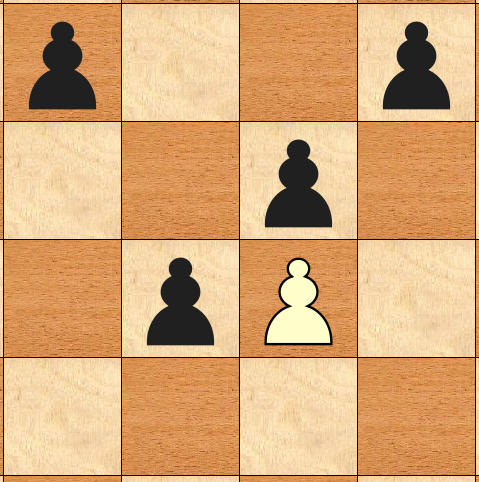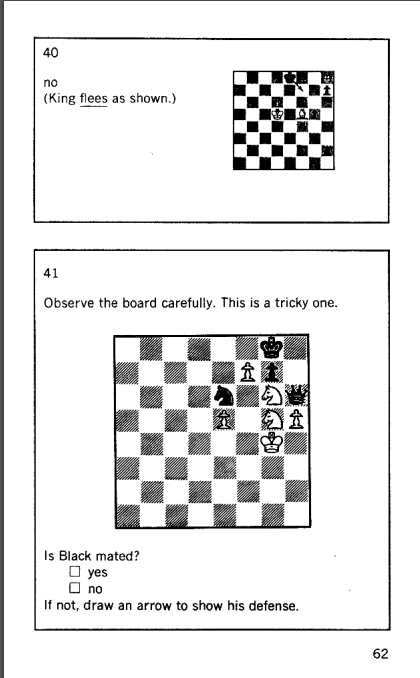Bobby Fischer Teaches Chess is a great introductory work to learn how to play chess and how to start studying chess. The book covers the basic rules such as how pieces move, en passant, castling, etc. but also gets into the strategy and tactics to win. It’s a great chess book early on in your learning of the game.

This is one of the first chess books in my chess library, but it was a foundational work. Like any work for beginners, it’s going to have some (arguable) shortcomings, but for any newer (or even intermediate player who has suffered a back-rank mate), it packs a lot of good information in an efficient format. I love this work because it covers so many basics so efficiently, and it’s accessible even in a line at the grocery store.
This isn’t a good book for you if you’ve read a bit about chess. The book itself isn’t bad – you just aren’t its target audience. This book is for beginners (primarily), and targets specific tactics which can help a newer player get more bang for their buck (arguably, defending against gambits and similar).
Layout
Bobby Fischer Teaches Chess is an introductory chess book which covers basic rules and basic tactics, as well as some heavy focus on back-rank mating. It covers covering and pinning pieces, power plays for checkmate, interpositions, and more. A lot of the theory is more focused on the endgame.
Bobby Fischer Teaches Chess begins by covering an introduction to the game, basic rules, and basic theory, and then moves on to bank-rank mates. From there, it progresses to defenses, then how to displace defenses. It finally moves on attacking pawn cover and culminates in a review of what it covers.
The book uses a “frame” system. Each frame is basically a “slide” or a question to be answered. For most of the work, a frame is a puzzle with an answer on the next physical page. This works out to a small answer section (if applicable) and a question or puzzle on each page. These will range from whether a move can achieve checkmate to how a given scenario can end in checkmate.

One confusing point some people have with the work is that it is printed with left pages “upside down” (past the introduction), and right pages are “normal”. It uses this to separate “frames” by page to make it easier to check answers. It doesn’t take that much getting used to (despite how hard some online reviews have made it sound) – it’s just a little different. The system is explained early on, but a lot of people just skip ahead and miss out on how it works.
This book is great for people just starting to get into chess, or people just starting to learn more formally. It might help some intermediate players who are self-taught (with specific weaknesses), but it’s tailored to new chess players.
The Good
This work uses a simple system which doesn’t require any formal notation. This is a con in some books, but shouldn’t be for the specific level this book targets. A grandmaster isn’t reading this book, someone early in their chess journey is. Cool, d3 is a common opening, but the reader of this book is learning to corner a king in ideal conditions.
The frame system is extremely efficient for learning. It doesn’t get super in depth with puzzles, though there are a few which require 4 moves or so to achieve checkmate. You get a board and some basic conditions to solve your puzzle. I didn’t need a board for any of the puzzles. A board may help, but the book is made to be relatively self-contained and easily accessible during down time in a busy schedule. This is a book you look at when waiting in line.
Bobby Fischer Teaches Chess focuses heavily on back-rank mating (e.g. where the king is at the very “back” of the board). If this is one of your weaknesses, this book will definitely pay dividends for your chess game. It helps you target and understand common gambits (albeit indirectly). You get a lot of bang for your buck while having it available anywhere.
About Back-Rank Mating
A lot of gambits focus on achieving a back-rank mating, as do a lot of beginner losses. The back-rank is the safest location for a king early on, but quickly becomes a liability once pieces start exchanging. The back is a wall for better – and for worse.
If you’re backed up against a wall and have the means to defend yourself it’s one thing, but most back-rank mates work based on power. You aren’t getting taken by the lone bishop or rook; you’re getting hammered by a group of pieces. That’s what makes chess so involved, setting up and preventing setups. This may involve sacrifices, pinning dangerous pieces, or even just brute force.
At a more advanced level, it’s pretty much common knowledge in the meta-game that keeping the king in the back becomes a liability sooner than later. You don’t need to toss him up front, but you need to always consider how you can evade encroaching forces if necessary (or at least outmaneuver them). Your king is very much an attacking piece (when necessary).
This work flips the newer player’s perception that a king is only a piece to be “defended” (albeit indirectly). The meta changes due to the power disparity and positioning which builds during a chess game. The focus on back-rank mating also highlights the easiest way to avoid it; don’t be on the back ranks when the opponent is prepping an attack (and leave a flight square or three).
The Cons
This book is laser-focused on back-rank mating (which is arguably a detractor anywhere past the beginning). If you bought it to learn more chess tricks and don’t know much, you’ll get a lot, but it isn’t a rounded out education.
The system is arguably at a lower ELO for most of the play. These puzzles were pretty easy for me on my first read through, though a few caught me off guard (comparatively). The level is pretty stable but there are some minor challenges mixed in. If you’re just starting to formally learn, this is arguably a boon, but it’s a con to most people who know who Bobby Fischer was (for chess at least). You’ll get some information, but this isn’t getting you to being an expert (or even good) in chess.
The book also never really gets heavily in depth with text or even examples. There are a few fleshed out sections per chapter, but a lot of it is a sentence or two, an example, and then some puzzles. This is compounded by the lower ELO which makes it hard for more advanced players to get through. That said, it’s so simple I read it during passive down time which made it a double-edged sword. It’s simple, but it’s low investment for each idea which is a mixed bag.
Summary
This isn’t necessarily the best chess book on the market but it’s a great addition to any newer player’s collection and a great work for focusing on back-rank mating at lower levels. The puzzles are simple and accessible, but also easily digestable. Some of the pros of this work become cons and vice versa. If you’re new to chess, this book is an amazingly accessible resource which you need to get. If you’re decent at chess, it might not do so much for you unless you have specific weaknesses.
I love this book despite its simplicity because it’s so easy to read. There isn’t notation to learn (algebraic is easy, but still, it takes some time to internalize when starting out), so, it’s extremely consumed in almost any scenario it’s socially acceptable to read. You can read it as a first book and not feel overwhelmed. Each frame is self-contained enough once you grasp the few pages of theory per chapter.
Again, this is an easily accessible work for beginners, but it does what it does well. I had originally learned to be extremely conservative with my king, but this work helped me break out of that habit. It’s a classic for a reason, and even though it’s mired in some level of controversy for the namesake or the methodology, it’s an extremely solid “first” chess book for a newer player. The limitations become advantages at the level it’s tailored for.
